
Cause of large slip of plate-boundary fault during the 2011 Tohoku-Oki earthquake clarified
A team of researchers from Osaka University identified the cause of the exceptionally large fault slip near the axis of the Japan Trench during the 2011 Tohoku-Oki earthquake. That is, friction-induced thermal pressurization increased interstitial fluid pressure around the fault, extremely lowering stress on the fault, leading to the large fault slip.
During the 2011 Tohoku-Oki earthquake, a great tsunami occurred due to a large slip of the plate-boundary fault near an ocean trench, causing extensive damage in the coastal regions. Since a large coseismic slip was thought to be unlikely to occur on the shallow portions of plate-boundary thrusts, in 2012, under the Integrated Ocean Drilling Program (IOPD), the Japan Trench Fast Drilling Project (JFAST) “Expedition 343 of the Integrated Ocean Drilling Program (IODP)” was conducted using Chikyu , a scientific drilling ship built for the program.
The expedition report said that the plate-boundary fault contained an abundance of weak clay (smectite), which caused thermal pressurization, producing the large slip. However, it had not been determined whether intrinsic weakness of fault materials or thermal pressurization was the primary cause of large slip on faults.
The Osaka University team evaluated the evolution of slip near the Japan Trench with and without thermal pressurization. For the cases in which thermal pressurization occurred at the plate-boundary fault, large slips near the trench were obtained; however, the case without thermal pressurization showed almost zero slip along the fault. Thus, they suggested that thermal pressurization (not the frictional properties of the fault rock) was the principal mechanism that produced the large slip near the trench during the 2011 Tohoku-Oki earthquake.
They identified the cause of the large slip (50~80m) of the plate-boundary fault was not the presence of smectite in the fault but rather, the dramatically decreased fault strength due to friction-induced thermal pressurization of interstitial fluid. They also quantified frictional properties of faults in rotary-shear friction experiments and performed dynamic rupture simulations by using their experimentally-obtained friction parameters, establishing a method for evaluating the potential of coseismic fault slip and properties of seismic waves generated from the fault.
This team’s research results will be applied in prediction of and disaster prevention by the imminent Nankai Trough earthquakes and earthquakes in subduction-zones in the world. In addition, the method for quantifying the magnitude of slip distance during earthquakes and what properties of earthquake waves generate from faults will allow for potential evaluations of inland active faults. Quantitative evaluations of the magnitude of fault slip and seismic wave properties of plate-boundary faults and active faults in and outside of Japan will contribute to earthquake prevention and disaster mitigation.

Figure 1

Figure 2
The article, “Role of weak materials in earthquake rupture dynamics” was published in Scientific Reports at DOI: https://doi.org/10.1038/s41598-019-43118-5 .
Related links

